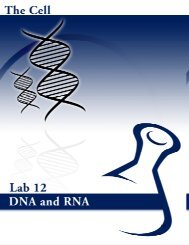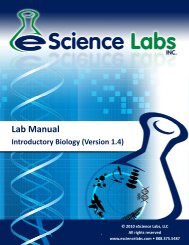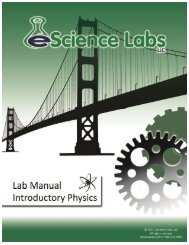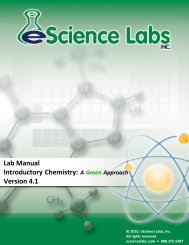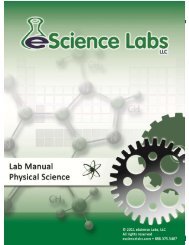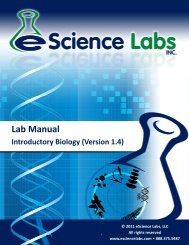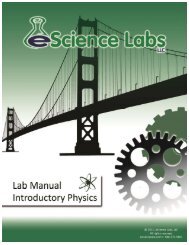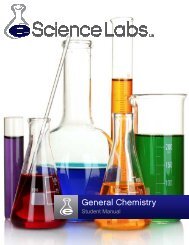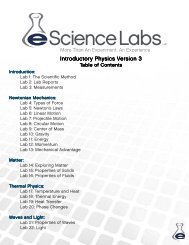Lab Manual - eScience Labs
Lab Manual - eScience Labs
Lab Manual - eScience Labs
Create successful ePaper yourself
Turn your PDF publications into a flip-book with our unique Google optimized e-Paper software.
<strong>Lab</strong> 9: Enzymes<br />
5. Make a serial diluon of yeast soluon by adding 10mL yeast soluon from Beaker A and transfer<br />
to Beaker B. Add 90 mL warm water (30-35°C) to Beaker B. Mix well by pipeng.<br />
6. Take 10mL yeast soluon from Beaker B and transfer to Beaker C. Add 90 mL warm water (30-<br />
35°C) to Beaker C. Mix well by pipeng.<br />
7. Into the first test tube, add 5mL from Beaker A.<br />
8. Quickly aach a balloon to the top of the test tube so that it will fill with the oxygen produced<br />
by the enzyme reacon. It is important to execute this step quickly so that every bit of gas produced<br />
will be captured.<br />
9. Repeat this procedure by transferring 5ml from Beaker B into test tube 2, aaching the balloon,<br />
and transferring 5 mL from Beaker C into test tube 3 and immediately placing the balloon<br />
on top.<br />
10. Swirl each tube to mix, and wait 30 seconds.<br />
11. Wrap the string around the center of the balloon to measure the circumference. Measure the<br />
length of string with a ruler. Record measurements in Table 1 below.<br />
12. Repeat step 11 for the remaining balloons.<br />
Table 1: Effect of Enzyme Concentraon on the Producon of Gas<br />
Tube Amount of yeast Balloon circumference (cm)<br />
1 0.05g<br />
2 0.005g<br />
3 0.0005g<br />
Quesons<br />
1. What is the enzyme in this experiment? What is the substrate?<br />
2. Did you noce a difference in the rate of reacon in the tubes with different concentraons of<br />
enzymes? Why or why not?<br />
100




